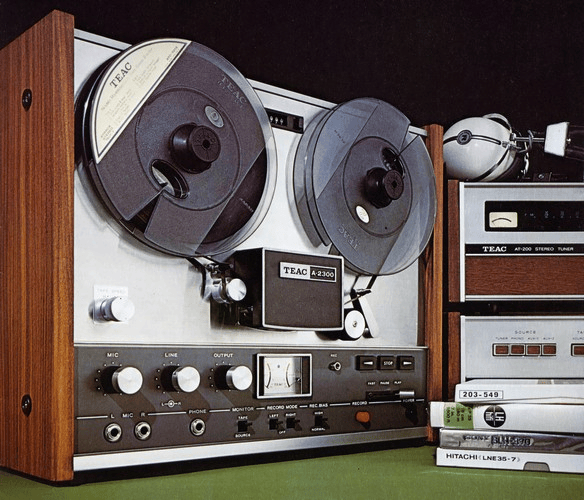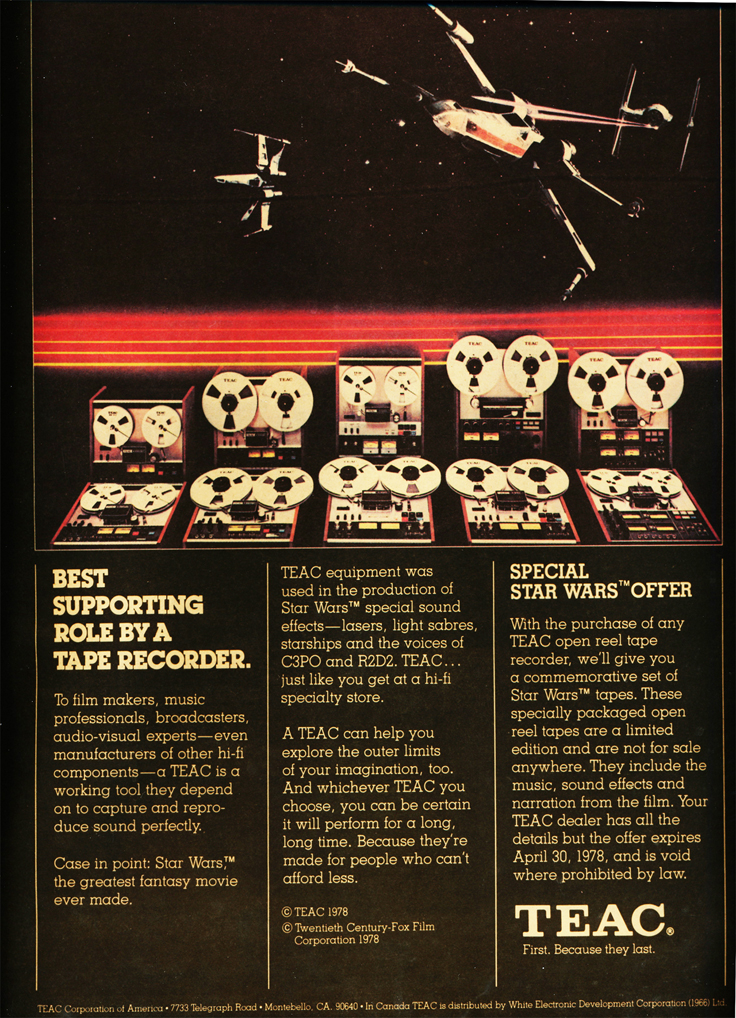Hi-Fi Hall of Fame
2024 Inductee
TEAC A-2300 Tape Recorder

Introduction
Our next inductee is the TEAC A-2300 reel-to-reel tape recorder, a classic 1970s era Hi-Fi component. The A-2300 is highly regarded for its build quality and performance in analog audio recording, and was a top seller for TEAC for a decade.
Let’s see what makes the TEAC A-2300 a “Hall of Fame” component.
Founding of TEAC Corporation
TEAC Corporation was founded in Japan in 1953. The company’s first factory was established in Musashino City, Tokyo, specializing in semi-professional audio components and general electrical appliances. Originally named Tokyo Television Acoustic Company, it employed Katsuma Tani, a former aviation and aeronautics engineer.
In 1956, Katsuma’s brother, Tomoma Tani, brought home a handmade three motor, three head stereo tape recorder. This sparked Katsuma’s fascination with reel-to-reel tape recorders. Convinced they could produce their own recorder, the Tani brothers founded the Tokyo Electro-Acoustic Company, later renaming it TEAC. They set up a factory in Chitose-cho, Sumida Ward, Tokyo, producing audio components, measurement and optical equipment, and tape recorders.

TEAC’s Early Recorders
It didn’t take long for TEAC to produce their first tape recorder.
The TEAC TD-102 was already in production by April 1957. It was based on an American recorder, the Ampex 300, which had been in production since 1949. TEAC sold a small quantity of TD-102 recorders to a major American retailer, Lafayette Radio Electronics.

The following year, TEAC was invited to demonstrate the TD-102 at the “Far East Audio Club” on the American Tachikawa military base. TEAC brought fifty recorders to the event, and they were all purchased. Word quickly spread and soon the TD-102 was selling briskly to both locals and foreigners. This gave TEAC management the confidence to continue developing recorders for both domestic and overseas markets.

By the early 1960s, TEAC was producing a wide range of tape recorders. Many of these were branded as “TEAC” for the Japanese market, while others were sold as “Concertone” and “Concord” for the American and other overseas customers.
By 1966, the company was selling TEAC-branded recorders all over the world. They had an excellent reputation for audio quality and reliability. TEAC offered a wide range of products for both consumer and professional users.
At that time, TEAC’s “entry level” recorder for home Hi-Fi enthusiasts was the Model A-1200, which was the predecessor for our Hall of Fame inductee. The A-1200 was marketed as a “Furniture Model”, because it had a beautiful wooden case and aesthetically was attractive enough to be placed in a typical home. It featured three motors for smooth control of the tape, and three heads (erase, record, and play) for optimum sound quality and to allow near real time monitoring of the recording. It was configured for four track, two channel (stereo) operation, and had two speeds. It was a physically imposing machine, measuring about 17 inches wide, 16 inches high, 11 inches deep, and weighing 46 pounds!



TEAC A-2300 Recorder
By the early 1970s, TEAC was selling a wide range of reel-to-reel tape recorders, all the way from amateur (home Hi-Fi) users to professional (studio) users. The company refreshed the product line by introducing a new line of recorders that would appeal to both high end home users and to professional users. The new lineup consisted of the A-2300, A-3300, A-4300, A-5300, A-6300, and the A-7300 recorders.
We chose the most affordable model from that series, the A-2300, to be inducted into the Hall of Fame. It had many qualifying characteristics: great audio performance, reliable mechanics and electronics, and a beautiful aesthetic. Over the next few years, TEAC introduced many new features and capabilities, and the A-2300 sold phenomenally well, in markets all over the world.

Despite the many changes over the years, every TEAC A-2300 recorder had a few common characteristics:
- Capable of 4-track, 2-channel stereo operation, allowing for recording on both sides of the tape, doubling the recording time
- Two tape speeds: 7.5 inches per second (ips) and 3.75 ips; the higher speed provided better sound quality, while the lower speed offered extended recording time
- The A-2300 was designed to handle reel sizes up to 7 inches in diameter, making it suitable for home audio enthusiasts and small studios
- Three head design, allowing the user to monitor the recording as it was being made
- Durable and beautiful construction, with a solid build quality, robust metal chassis, and wooden panelled sides
- VU meters for monitoring recording levels and individual level controls for each channel, allowing for fine-tuned adjustments
TEAC A-2300 Models
Throughout the 1970s, TEAC produced several different versions of the A-2300. The “original” model was the A-2300, which was an outstanding performer at the time. It employed a combination of electronic and mechanical controls, perhaps the recorder’s only weakness, but the sound quality was excellent.
TEAC soon released an improved model, the A-2300S, which introduced fully electronic (solenoid) controls. This made operation of the deck much smoother, and also made it possible to remotely control the deck.

Later, TEAC released a “cost reduced” version called the A-2300SX, which was designed to make the recorder available to a wider audience. You can recognize this model because it has black (instead of silver) controls.

TEAC produced the A-2300SD which added “Dolby B” noise reduction capability to reduce tape hiss. The deck included a built-in calibration tone and a “Dolby FM Copy” feature for recording from FM radio stations that were broadcasting with Dolby.

During the 1970s, four track recorders became popular. These could be used for recording quadraphonic (4 channel) audio, and could also be used in small recording studios. So TEAC released a 4-track version called the A-2340. Later, the company released the A-2340S version with improved controls.


Reverse playback was a popular feature on many reel-to-reel recorders. This allowed the user to play both sides of the tape without removing the reels and “flipping” the tapes around. For these customers, TEAC offered two new models, the A-2300SR with automatic reverse operation, and the A-2340R with manual reverse.

TEAC’s final version of the recorder was the A-2340SX, which was a four track deck with “Simul-Sync” technology. This allowed the user to listen to one track while simultaneously recording on the other channels. This feature could be used to record multiple tracks at different times, to over-dub or remix music, or to create sound effects.

TEAC A-2300 Role in Hollywood
Benjamin Burtt Jr. (born July 12, 1948) is an American sound designer, film editor, director, screenwriter, and voice actor. As a sound designer, his credits include the Star Wars and Indiana Jones film series, Invasion of the Body Snatchers (1978), E.T. the Extra-Terrestrial (1982), WALL-E (2008) and Star Trek (2009).
Burtt is notable for popularizing the “Wilhelm Scream” movie joke and for creating many of the iconic sound effects heard in the Star Wars film franchise, including the ‘voice’ of R2-D2, the lightsaber hum, the sound of the blaster guns, and the heavy breathing sound of Darth Vader. Burtt was also the sound editor for WALL-E and performed the vocalizations of the titular character as well as other robots in the film. Burtt has won four Academy Awards, two of which are Special Achievement Academy Awards. He has also directed numerous documentary films and was the editor of the Star Wars prequel trilogy.
Burtt often used a TEAC A-2300 in his studio to create all of these beautiful movie sounds. Here’s a photo of Benjamin Burtt Jr. working his magic with a small collection of TEAC recorders and related equipment.


The Decline of Reel-to-Reel Recorders
In the late 1970s, TEAC discontinued the A-2300 series. It had been a tremendously successful product, and the company even published advertisements showcasing the tremendous sales figures of the A-1200 and A-2300 lines. Here are a couple of those ads. With over 225,000 recorders sold, the TEAC A-2300 series must be one of the best selling reel-to-reel recorders of all time.


By the 1980s, the performance of “Compact Cassette” recorders was improving to the point where they were almost as good as reel-to-reel recorders. Cassettes were easier to use and less expensive to manufacture, as well. As cassette technology improved, Hi-Fi enthusiasts gradually lost interest in reel-to-reel recorders, and sales declined. TEAC released their last series of reel-to-reel recorders around 1986.
Despite the end of the “Reel-to-Reel” era, TEAC has continued to produce great Hi-Fi equipment, and in 2023 the company celebrated their 70th anniversary. One of their ads even showcased that original TD-102 recorder.

TEAC continues to produce great Hi-Fi equipment, including amplifiers, turntables, and even some cassette decks. If you’d like to see their current products, click on this link:
If you’d like to read the history of TEAC, starting back in 1953, check out TEAC’s “History” page:
Induction to the Hi-Fi Hall of Fame
The TEAC A-2300 is a worthy addition to the Hall of Fame. It is a beautiful, affordable, and reliable reel-to-reel recorder that sold in huge numbers. Hundreds of thousands of people incorporated a TEAC A-2300 series recorder into their home ot studio.
It was one of the world’s first consumer decks to offer “Simul-Sync” recording and four track capability, which made it possible for folks on a limited budget to set up their own recording studio. When TEAC upgraded the deck with electronic controls, Dolby noise reduction, and other features, it turned a great deck into a superb deck.
Vintage TEAC A-2300 are still in demand by audiophiles in the used marketplaces. There are repair kits and restoration services available to repair the machines and to replace worn out components.
Last but not least, the TEAC A-2300 played a supporting role in a number of great Hollywood movies.
For all of these reasons, the TEAC A-2300 is the first reel-to-reel recorder to be inducted into the Hi-Fi Hall of Fame.
